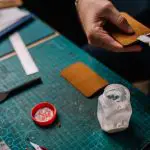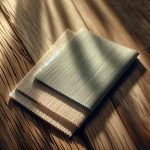I've found that Tencel, a sustainable fabric made from wood pulp, can be incredibly long-lasting. With proper care, Tencel garments have the potential to last over 22 years, which really sets them apart from other fibers like cotton and polyester. What's key is how you maintain them. You should wash them gently, use mild detergents, and avoid high heat when drying. Not only does this keep the softness intact, but it also helps retain their strength and luxurious feel for years. I've noticed that knowing how to correctly care for Tencel can significantly extend its lifespan. There's a bunch more useful tips on how to make your Tencel items last even longer.
Table of Contents
Key Takeaways
- Tencel fabric can potentially last over 22 years with proper care.
- It is resistant to thinning, pilling, and fading, enhancing its durability.
- Regular washing on a gentle cycle and using mild detergent helps maintain its quality.
- Avoiding high heat in washing and drying preserves the fabric's strength and softness.
- Tencel's closed-loop production process contributes to its sustainability and long lifespan.
Understanding TENCEL™ Fabric
Tencel is a sustainable fabric made from wood pulp that's known for its softness and durability. As someone who's always on the lookout for eco-friendly materials, I've delved deep into the qualities that make Tencel a standout choice. This fabric isn't just gentle on the skin; it's built to last. With a potential lifespan of over 22 years, its longevity is quite impressive.
What really sets Tencel apart for me, though, is its moisture-wicking ability. Living in a humid climate, I find this feature particularly beneficial. Tencel pulls moisture away from the body, helping to keep me cool and comfortable throughout the day. This isn't just comfortable—it's also healthier for the skin, reducing the risk of irritation.
Moreover, the strength and durability of Tencel ensure that garments and textiles maintain their shape and texture even after multiple washes. This means less need for frequent replacements, which isn't only good for my wallet but also for the planet. Opting for Tencel has allowed me to enjoy supreme softness and comfort without compromising on environmental values or durability.
Tencel™ Vs. Other Fibers
When comparing Tencel™ to other fibers, its durability and eco-friendly qualities really stand out. I've found that not only does Tencel™ offer a robust lifespan—shirts lasting over 22 years—but its environmental benefits are equally impressive. It's biodegradable and made from renewable wood fibers, which helps in reducing waste and promoting sustainability.
Here's a quick rundown of how Tencel™ stands against other common fibers:
- Moisture-Wicking Abilities: Tencel™ excels in pulling moisture away from the body. This feature makes it superior for maintaining comfort in various climates, notably more efficient than cotton or polyester which can retain moisture longer and lead to discomfort.
- Softness and Skin-Friendliness: Its softness is next level! Tencel™ is softer than cotton, which often makes it the go-to for those with sensitive skin. Unlike synthetic fibers, which can cause irritation, Tencel™ provides a smooth, irritation-free experience.
- Breathability: The natural materials in Tencel™ allow it to be highly breathable. This characteristic ensures a cool, comfortable sleeping or wearing experience, outshining less breathable options like polyester.
For those who value durability, comfort, and eco-responsibility, Tencel™ is a standout choice.
Factors Affecting TENCEL™ Durability
Several factors influence the durability of TENCEL™, ensuring it remains a reliable choice for long-lasting wear. First off, let's talk about the closed-loop production process. This not only supports sustainability but also boosts the durability of the fabric. By reusing solvents and water, it ensures that the fibers are well-preserved and robust, contributing significantly to their longevity.
Another key factor is TENCEL™'s resistance to thinning, pilling, and fading. These characteristics are crucial because they mean your clothes won't look worn out after just a few uses. You know how annoying it's when your favorite shirt starts looking fuzzy or loses its color? Well, that's less likely with TENCEL™. This resistance helps maintain the fabric's quality and appearance over time, enhancing its overall lifespan.
Moreover, TENCEL™ sheets and other products can endure frequent washings without losing their integrity. This is a big deal if you're like me and laundry seems endless. The fabric maintains its strength and softness wash after wash, which isn't something you can say about all materials.
Lastly, investing in high-quality Tencel products is wise. They might cost a bit more, but they offer better longevity, proving that sometimes, you really do get what you pay for.
Proper Care for TENCEL
To keep your Tencel items in top shape for years, it's crucial to follow specific care guidelines. Tencel sheets, known for their durability and long lifespan, demand a certain level of maintenance to retain their quality. Here's how I ensure my Tencel sheets stay soft and durable through the years:
- Machine Wash Gently: Always use the gentle cycle when machine washing your Tencel sheets. It's easy to just toss them in with the rest, but taking this extra step helps preserve their fibers from harsh agitation.
- Use Mild Detergent: I stick to mild detergents, avoiding any that contain harsh chemicals. This helps in maintaining the softness and integrity of the sheets without exposing them to substances that could degrade the fabric.
- Avoid High Heat Drying: High temperatures can be a nightmare for Tencel. I always air dry my sheets or use a low heat setting if I must use a dryer. This prevents any potential damage from high heat and contributes to their longevity.
Practicing these care tips ensures my Tencel sheets continue to offer comfort and retain their luxurious feel, proving that a little proper care goes a long way.
Common TENCEL™ Care Mistakes
While I've shared how to properly care for Tencel, it's also important to highlight some common mistakes people make. Often, folks don't realize that the durability and longevity of Tencel largely depend on how it's maintained. For example, using high heat in the washing machine or dryer can severely damage Tencel fibers, compromising their softness and strength. It's tempting to think that more heat means more clean, but that's not the case here.
Another frequent slip-up is the use of harsh detergents. These can break down Tencel's delicate fibers over time, shortening the lifespan of your items. I've seen many make this error, assuming that stronger chemicals will result in a better clean. However, the opposite is true; gentle detergents are your best bet for preserving the fabric's integrity and softness.
Lastly, many people overlook the care label's instructions, which can lead to unfortunate mishaps. It's crucial to follow these guidelines closely to ensure your Tencel products remain in top shape. By avoiding these care mistakes, you're not just maintaining the fabric; you're investing in sustainable, long-lasting quality.
Signs of Wear in TENCEL
Despite its durability, Tencel sheets can show signs of wear like thinning fabric or pilling after extended use. Even though Tencel is renowned for its longevity, knowing what to look for in terms of wear can really help in maintaining your sheets in top condition for as long as possible.
Here are three key signs of wear to watch for in your Tencel sheets:
- Thinning Fabric: Over time and with frequent washes, you might start noticing that your sheets feel less substantial. Thinning typically occurs from repeated use and washing, which can gradually break down the fibers.
- Pilling: This happens when little balls of fiber start forming on the surface of the sheets. Pilling can make your sheets feel rough and can be a sign that they're beginning to wear out. Although some pilling is normal, excessive pilling indicates that the sheets mightn't be receiving the proper care they need.
- Fading Color: Although not as directly related to the fabric's integrity, fading color can be a sign of wear. It often indicates that the sheets have been exposed to harsh detergents or too much sunlight.
Regularly checking these aspects and following the proper care instructions are crucial for maintaining the durability and quality of your Tencel sheets.
Maximizing TENCEL™ Lifespan
Knowing how to properly care for your Tencel sheets can significantly increase their lifespan. Let's dive into a few tips that'll help you maintain their quality and extend their longevity.
First off, always opt for gentle washing cycles. Tencel thrives under low mechanical stress, so treating it tenderly in the wash is key. This means setting your washing machine to a delicate cycle and using mild, eco-friendly detergents.
Avoiding high heat when drying your Tencel items is equally crucial. High temperatures can break down the fibers over time, reducing their durability. Instead, air dry your Tencel garments or use a low heat setting if you must use a dryer. This precaution helps maintain the fabric's integrity and prevents issues like thinning or pilling.
Choosing high-quality Tencel products from reputable brands is another smart move. Higher quality often means better durability, ensuring that your Tencel items don't just feel great but also last longer. Remember, investing in good quality is investing in the extended lifespan of your textiles.
TENCEL™ in Different Products
Now, let's talk about how TENCEL™ shows up in different products.
You'll find it in durable clothing, cozy home textiles, and even in some industrial applications.
Each use highlights TENCEL™'s versatility, sustainability, and performance.
TENCEL™ Clothing Durability
Tencel clothing really stands the test of time, maintaining its shape, color, and strength through frequent wear and washes. It's become a go-to for anyone looking for high-quality, durable fabrics. Here's why:
- Strength and Resilience: Tencel fibers are incredibly strong, contributing to the longevity of garments. They resist wear and tear remarkably well, making them a lasting wardrobe investment.
- Color and Shape Retention: These garments keep their vibrant color and shape, even after multiple wash cycles, ensuring they look new for years.
- Sustainable Care: With proper care, Tencel clothing can last for years, reducing the need to buy replacements and promoting a sustainable lifestyle.
I've found that investing in Tencel clothing isn't just smart—it's sustainable!
TENCEL™ Home Textiles
Exploring the versatility of TENCEL™, I've discovered its widespread use in home textiles like bedding and towels, which aren't only luxurious but also durable and sustainable. It's amazing how TENCEL™ brings out the softness in these products, making every touch soothing. The fabric's breathability adds to the comfort, ensuring a good night's sleep or a refreshing wipe after a long day. What's more, its durability means I'm not replacing my sheets or towels often, which is great for my budget and even better for the planet.
The eco-friendly nature of TENCEL™ aligns perfectly with my desire to make responsible choices. Using TENCEL™ in home textiles isn't just about luxury; it's about making a sustainable choice without sacrificing quality.
TENCEL™ Industrial Applications
While I've enjoyed the comfort of TENCEL™ in my home, it's also making strides in various industrial applications. Tencel's unique properties derived from renewable wood fibers make it an ideal choice beyond just personal use. Here's how Tencel is revolutionizing different products:
- Clothing: Tencel's softness and durability provide long-lasting comfort, making it perfect for eco-friendly fashion.
- Bedding: Its moisture-wicking and breathable qualities enhance sleep by keeping bedding fresh and hygienic.
- Towels: These eco-friendly towels offer superior moisture management, ensuring they stay dry and odor-free longer.
Tencel truly excels in sustainability and functionality, making it a top choice for a variety of products that meet the needs of environmentally conscious consumers.
Recycling and Upcycling TENCEL
Now, let's talk about how Tencel gets a new life through recycling and upcycling.
It's not just about turning old Tencel into new threads; there's a whole range of creative ways to reuse this sustainable fabric.
We'll explore the processes involved, the benefits, and some really cool ideas for giving Tencel a second chance.
Tencel Recycling Processes
I'll kick off by explaining how Tencel gets recycled and upcycled, which boosts its sustainability in the textile industry. Due to its durability and resistance, Tencel can withstand multiple recycling processes, making it an ideal candidate for sustainable textile production.
Here's a quick rundown of these processes:
- Collection and Sorting: Used Tencel items are collected and sorted based on quality and condition.
- Fiber Reclamation: The sorted items undergo a treatment to break down the fibers, preparing them for a new lifecycle.
- Upcycling into New Products: These reclaimed fibers are then transformed into new, valuable products, extending their usability and reducing waste.
Each step ensures Tencel's role in promoting a more sustainable future.
Benefits of Upcycling Tencel
Upcycling Tencel not only reduces waste but also turns old products into new, sustainable treasures. By transforming used Tencel items, we're not just tossing them aside; we're giving them a second life.
This process keeps recycled fibers in circulation, bolstering the circular economy. It's all about minimizing our environmental footprint, right? When I choose to upcycle, I'm contributing to sustainability by reducing the demand for new raw materials. This means less strain on our natural resources and a lighter impact on the planet.
Plus, the quality of Tencel allows these recycled products to retain their original softness and durability. It's a win-win for both the environment and smart textile production.
Innovative Tencel Reuse Ideas
Building on the idea of upcycling, let's explore some innovative ways to reuse Tencel in both recycling and upcycling projects. Given its durability and versatility, Tencel offers exciting possibilities.
- Fashion Forward: Upcycle old Tencel garments into trendy accessories like scarves, belts, or even jewelry. It's a stylish way to reduce waste.
- Home Decor Overhaul: Create home textiles such as cushion covers or curtains from upcycled Tencel. Its texture adds a chic touch to any room.
- Artistic Expression: Use recycled Tencel fibers in mixed media art projects. The material's versatility makes it ideal for innovative reuse in creating unique, sustainable art pieces.
Each idea leverages Tencel's qualities to foster sustainability creatively.
Frequently Asked Questions
What Is the Disadvantage of Tencel Fabric?
The main disadvantage of Tencel fabric is its higher initial cost compared to other materials. Though its durability often offsets the price, the upfront expense can be a drawback for some budgets.
Does Tencel Degrade?
Tencel doesn't degrade quickly; it's quite durable and maintains its quality over time. I've found that with proper care, my Tencel clothing remains soft and strong, even after many washes.
Can You Put Tencel in the Dryer?
I've found that you can put Tencel in the dryer, but it's best to use low heat to avoid damaging the fabric. Air drying is safer if you want to extend its lifespan.
Does Tencel Stretch Over Time?
Tencel doesn't really stretch over time; its unique fiber structure helps it maintain its shape. I've noticed it stays true to size with regular care, making it a great long-term fabric choice.
- How Does Ring Spun Cotton Affect Garment Fit and Shape Retention? - August 13, 2024
- What Are the Challenges in Producing Ring Spun Cotton? - August 13, 2024
- Is Ring Spun Cotton Suitable for Plus-Size Clothing? - August 13, 2024







